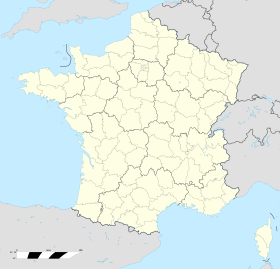Ouvrage Latiremont
| Ouvrage Latiremont | |
|---|---|
| Part of Maginot Line | |
| Northeast France | |

Block 6, front
|
|
| Coordinates | 49°27′40″N 5°44′35″E / 49.46104°N 5.74293°E |
| Site information | |
| Controlled by | France |
| Site history | |
| Built by | CORF |
| In use | Abandoned |
| Materials | Concrete, steel, deep excavation |
| Battles/wars | Battle of France, Lorraine Campaign |
| Ouvrage Latiremont | |
|---|---|
| Type of work: | Large artillery work (Gros ouvrage) |
|
sector └─sub-sector |
Fortified Sector of the Crusnes └─Sub-sector of Arrancy |
| Work number: | A3 |
| Regiment: | 149th Fortress Infantry Regiment (RIF) |
| Strength: | 21 officers, 580 men |
Ouvrage Latiremont is a gros ouvrage of the Maginot Line, located in the Fortified Sector of the Crusnes, sub-sector of Arrancy. It lies between the gros ouvrage Fermont and the petit ouvrage Mauvais Bois, facing Belgium. The village of Doncourt-Cités is nearby. Latiremont was active in 1939-1940, coming under direct attack in late June 1940. It surrendered to German forces on 27 June. After renovations during the Cold War, it was abandoned.
The site was surveyed by CORF (Commission d'Organisation des Régions Fortifiées), the Maginot Line's design and construction agency, in early 1931. Latiremont was approved for construction in May 1931. It was completed at a cost of 88 million francs by the contractor Monod of Paris. Latiremont was designed from the beginning as a gros ouvrage with casemate-mounted 75mm guns. A second phase was planned, to add 75mm and 135mm gun turret blocks. By the late 1930s resources had been allocated elsewhere, and the turret blocks were not built.
More than 1,200 metres (3,900 ft) of underground galleries connect the entries to the farthest block, at an average depth of 30 metres (98 ft). An "M1" magazine, arranged with parallel galleries connected by cross galleries, is located close to the ammunition entrance, while the underground barracks and utility areas are just inside the personnel entry. The gallery system was served by a narrow-gauge (60 cm) railway that continued out the ammunition entry and connected to a regional military railway system for the movement of materiel along the front a few kilometers to the rear. Several "stations" along the gallery system, located in wider sections of gallery, permitted trains to pass or be stored.
Latiremont has two entrances and six combat blocks. Most of the blocks are in and around the Bois de Pracourt.
Unbuilt blocks:
A series of detached casemates and infantry shelters surround Latiremont, including the:
None of these are connected to the ouvrage or to each other. The Casernement de Doncourt provided peacetime above-ground barracks and support services to Latiremont and other ouvrages in the area.
The 1940 manning of the ouvrage under the command of Commandant Pophillat comprised 21 officers and 580 men of the 149th Fortress Infantry Regiment. The units were under the umbrella of the 42nd Fortress Corps of the 3rd Army, Army Group 2.
...
Wikipedia

